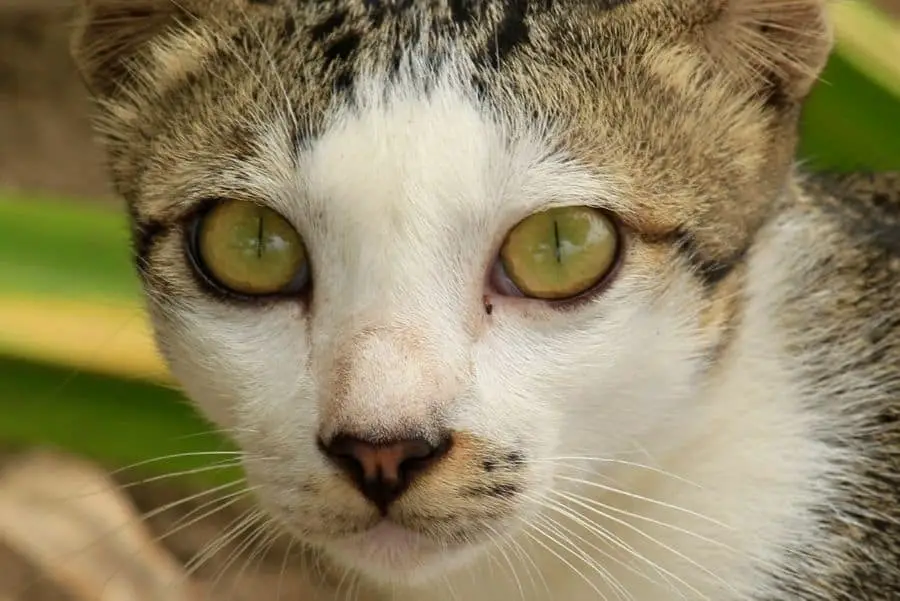More Meows is an Amazon Associate. As an Amazon Associate we earn from qualifying purchases. We may also earn commissions if you purchase products from other retailers after clicking on a link from our site.
A cat living outdoors can make one feel sad and worried for their safety and health. Bringing the cat indoors, sheltering it from danger, and keeping it in a warm home would make one feel happier. Feral cats want to live in the outdoors as they are wild cats.
No, Feral cats usually do not want to be indoors. Feral cats are happier and safer living outdoors. They have made the outdoors their home. Feral cats are exceedingly difficult to tame, but in some cases, it is possible. Earning the feral cat’s trust is a key step in potentially bringing them indoors.
Think about what the feral cat wants before deciding they should live indoors. They are independent cats; the outdoors is the home they know and where they feel safe.
Before trying to tame a feral cat to adopt or put it up for adoption, see whether there are domestic cats in the area that need a home. Domestic cats are out of danger in your home; then, they would be living in the wild, unlike a feral cat.
There is a significant difference in socialization between a feral cat and a semi-feral cat. This is the deciding factor as to whether these cats can become inside-friendly cats. In most cases, you will find that feral cats will want to stay outdoors and not want to live indoors.
Can you Keep a Feral Cat Indoors?
You might be able to keep a feral cat indoors. In most cases, feral cats are better off living outdoors. Feral cats love living outdoors, and this is what is familiar to them. These cats are fully capable of finding food and defending themselves in the wild.
Forcing a feral cat to live indoors and try to become domesticated can be like forcing a person to live in the wild. It is not their preferred and most comfortable habitat.
Feral cats can live a healthy life, they have low rates of getting diseases, their life span is the same as a domestic cat, and they have healthy weights.
There are many risks to living outdoors, but they have learned how to survive through instinct.
Can you Tame a Feral Cat?
A semi-feral or stray cat can be tamed. If the cat is completely feral, it is best to keep the cat wild as this is what is best for them.
An adult feral cat can become tame to a point, but this is extremely difficult to do, and it is not guaranteed success.
A feral kitten might be tamed at any age, but the older they get, the harder it becomes. Feral kittens (and cats) can be unpredictable. It is recommended to tame them before four months of age. The older they are, the more patience is needed, and it is not guaranteed.
If the kitten is below eight weeks old, it can be socialized very easily by anyone. If they are between 2 to 4 months old, it will take more patience and skill to tame the kitten.
The kitten’s personality starts to develop between the 4 to 8 months. This period will indicate whether this cat can become tame or if it should be returned to the wild.
If the kitten begins to show signs of socialization with humans during this time, they will easily be able to be adopted into a family. If there is no sign of socialization within a week, then it would be best for the kitten to be returned to its natural wild habitat.
A semi-feral or stray cat can become tame under the right circumstances. Potentially taming a feral cat takes a lot of time and a lot of perseverance.
How to Tame a Feral Cat

These steps can be used to domesticate a semi-feral or stray cat. These steps can be used for an adult feral cat, but the outcome is not guaranteed.
1. Let the feral cat decide if it wants human interaction.
Give the cat space and allow it to decide whether it wants human interaction.
Cats are very curious; not giving the cat any attention will initially encourage them to make the first move.
2. Encourage the feral cat to come back.
Make sure the environment is relaxed and safe.
Food is a good way to form trust with animals. When the cat comes back, provide food or a treat.
I mentioned the food above, but what about fresh water? Check out my article to learn if feral cats drink water: Click Here.
The cat will initially prefer having the treat at a comfortable distance from where you are standing.
Move forward slowly as the cat begins to trust you. If the cat becomes nervous, then move away until it starts eating again.
Be diligent. Progress will be seen once the cat can eat next to you or out of your hand.
3. Earn the feral cat’s trust.
Wild cats are not used to human interaction; loud talking and human noises scare them.
Help desensitize the cat to human interaction during feeding times. When the cat is eating, talk softly to it, keep the radio or TV playing in the background, and do small tasks that are not too noisy.
Calming remedies such as catnip, calming supplements, or pheromone sprays may be used to help calm a cat. This will help cats feel more relaxed in your home.
Semi-feral cats can be tamed within a few weeks to a year. Remember to interact with the cat daily, respect its space, and provide a peaceful environment for the cat to call home.
How to Tame a Feral Kitten
A feral kitten can potentially become tame using the steps below.
1. Separate the feral kittens.
Separating the kittens will improve the success rate and the time it takes to tame them.
Make each one a temporary home, such as a large kennel with its place to sleep, litter box, food, and water.
Keep a radio or television switched on in the room to help them get used to the voices and sounds of humans.
Keep the kittens in this new environment for at least 24 hours before moving to step two.
2. Picking up a feral kitten.
During the process of domesticating kittens, it is vital to pick them up and hold them.
Feral kittens are very scared of people; they may hiss and or scratch when picked up. Wear gloves and thick protective clothing in case of this.
Pick up a feral kitten from behind and on the loose skin found on the top of their neck. Bring the cat up into your stomach, securing it with a towel or blanket.
Touch, stroke, and talk softly to the kitten for 5 minutes, initially building up to 20-30 minutes several times a day. The kitten will soon become friendlier and enjoy attention.
Progress will be seen when the kitten starts purring when being held.
If you are interested in learning more about feral kittens and if their mothers will abandon them, check out my article on the subject: Click Here.
3. Earning the feral kitten’s trust.
Socialize and earn the kitten’s trust during feeding time. During the day, keep dry food and water in their kennel.
Wet food is a treat for them; give this to them when you are in the room. The kitten will associate you with good food. This can be done with soft treats as well.
Place the food next to the kitten, see if the kitten will eat while you are standing next to them. If not, then move back until they start eating.
Once the kitten starts eating, move closer until you can touch the kitten. If the kitten stops eating, then move back until it eats again.
If the kitten doesn’t eat at all, then take the food away and try another time.
Progress will be seen once the kitten starts eating out of your hand.
4. Interacting with a feral kitten.
Once a kitten enjoys being held, you can move to this step.
Place the kitten in a room with the door shut and with no places to hide.
With a toy or string, encourage the kitten to play. If the kitten is not confident, then get one of the other kittens so they can play together.
Kittens will start playing around 3-4 weeks of age.
5. Introducing people to feral kittens.
The feral kitten will be comfortable around the person caring for them, but they may be scared of other people.
Socialize the feral kitten with new people. Allow them to hold and play with the kitten. This will help with the adoption process later.
If some kittens don’t become domesticated, then it is best to spay or neuter them at eight weeks old, vaccinate them and find a safe outdoor home for them.
What Is A Feral Cat?
A feral cat is a wild cat that has had no contact with a human, contact has been minimal, or their contact with humans has reduced over the years.
Feral cats are usually scared of humans and will try to avoid any contact with them.
Difference Between a Feral and Semi-Feral Cat
A semi-feral cat has had some experience or contact with humans. They may have been domesticated or lived with humans at some point in their lives; these are also known as stray cats.
These once domesticated cats may have been abandoned or lost their home, which caused them to learn how to survive in the wild.
A semi-feral cat may have also lived as a wild cat but has been in some contact with humans either through feeding or medical care.
Semi-feral/ stray cats will avoid physical contact with a human, but they are not scared of being around or near humans. When around humans, they may be vocal and make eye contact.
To learn more about the simple reasons that stray cats may be friendly, check out my article: Click Here.
Feral cats are wild and don’t really want contact with humans. You will probably notice that they run away from humans rather than interact with them. This lack of desire for human interaction is what will make taming a feral cat exceptionally hard and one of the big reasons for the release phase of the trap, neuter, and release policies that many local cat organizations have.
Feral cats are probably far superior hunters to domesticated cats. There has been a lot of research in recent years on how one good hunting feline can have a huge impact on a local ecosystem, and this is probably true with feral cats.
Conclusion
Not all feral or semi-feral cats or kittens are meant to be domesticated; let them live outdoors where they belong.
Taming a feral cat can be time-consuming and take a lot of patience, but it can also be rewarding in the end.
If there are any wild cats in the area and they may be in danger or sick, then don’t hesitate to contact your nearest animal rescue center or veterinary hospital. It is probably best if you can avoid handling this yourself.
If you enjoyed this article, please check out a few others:
- Do Feral Cats Purr? Quick Reasons You Need To See: Click Here.
- Do Feral Cats Meow? Remarkably Interesting Reasons: Click Here.
- Can Stray Cats Survive A Hurricane? The Revealing Ways: Click Here.
